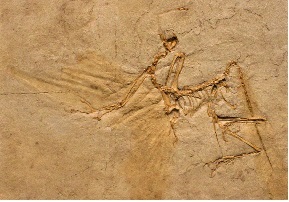Archaeopteryx (meaning "old wing") - The Munich specimen was unearthed in pieces, in 1992, in the Langenaltheim quarries. The specimen was initially pieced together by Jurgen Huttinger, the person who found it. The final preparations were made by Ernst Schmieja. During that preparation it was determined that the tip of the wing was missing. They frantically searched through a half metric ton of slabs that had been collected and saved from the same layer before finding the missing piece.
The exact limestone layer that the Munich specimen is from is the highest in the Plattenkalk profile of the Upper Solnhofen limestones. It is therefore the youngest. The Maxberg and London specimens were found in the same area. The Maxberg was found 8.5 meters below the Munich and the London 14.5 meters below. This would indicate that the Maxberg was 45,000 years and the London about 75,000 yuears earlier than the Munich specimen.
Initially the specimen was offered for sale well into the millions of deutschmarks. It was finally sold to the Bavarian State Collection for two million deutschmarks. So, after having passed or being outbid for the London specimen at 700 pounds sterling, Munich finally obtained an Archaeopteryx specimen.
The Solnhofen beds have long been mined for their fine grained limestone which is perfect for lithographic printing. These Late Jurassic beds are also renowned for producing marine and terrestrial animal and plant fossils of exquisite preservation. During the Late Jurassic, the Bavarian region of Germany was a series of islands and coastal lagoons. Any creatures remains that were washed into one of these lagoons would lay undisturbed and unscavenged. Layers of fine marine sediment would cover the remains, leading to nearly flawless preservation.
Kingdom: Animalia, Phylum: Chordata, Clade: Dinosauria, Saurischia, Theropoda, Aviadae, Family: Archaeopterygidae, Genus: Archaeopteryx, Species: Lithographica. Aviadae is the only clad of flying dinosaurs, the birds. It is usually defined as all theropod dinosaurs which are more closely related to modern birds (Aves) than to deinonychosaurs.
Archaeopteryx lithographica - Munich specimen 
Quantity in Basket: None
Code: AVE-103
Price: $222.00
Shipping Weight: 5.21 pounds
Dimensions: 23-1/8" x 19-3/4" x 1-1/4"